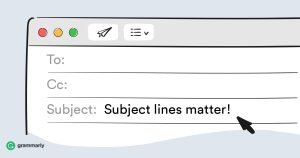Supercharge Your Business: Crafting a Top-Notch Email Marketing Campaign
Email marketing is a tried-and-true method for businesses to connect with their audience and drive results. In this article, we’ll guide you through creating a winning email marketing campaign that grabs attention and boosts your brand.
Crafting Compelling Email Content
Your email’s content is the heart of your campaign. Make it shine.
1. Captivating Subject Lines
Craft subject lines that pique curiosity and promise value. Example: “Unlock Exclusive Discounts: Don’t Miss Out!”

Captivating Subject Lines
The subject line of your marketing email is the first thing your recipients see, and it’s your one chance to make a compelling impression. A captivating subject line can entice your audience to open the email, while a lackluster one can send your message straight to the trash folder. Here’s a closer look at how to create subject lines that truly captivate:
1. Clarity and Relevance
A good subject line should be clear and directly related to the content of your email. It should convey the essence of what the recipient can expect when they open it. Avoid vague or misleading subject lines, as they can lead to distrust and unsubscribes.
2. Personalization
Personalization is a powerful tool in email marketing. Use the recipient’s name or tailor the subject line to their interests or previous interactions with your brand. For example, “John, Your Exclusive Offer Awaits!”
3. Urgency and Exclusivity
Create a sense of urgency or exclusivity in your subject lines. Phrases like “Limited Time Offer” or “Exclusive Access” can compel recipients to open your email promptly, fearing they might miss out.
4. Ask Questions
Engage your audience by posing a question in the subject line. Questions pique curiosity and encourage recipients to open the email to find the answer. For instance, “Are You Ready to Transform Your Business?”
5. Benefits-Oriented
Highlight the benefits of opening your email. Let recipients know what’s in it for them. For example, “Boost Your Productivity with Our Proven Tips.”
6. Use Numbers and Lists
Numbers and lists in subject lines can be attention-grabbing. They imply a clear and organized message. For example, “5 Secrets to Skyrocket Your Sales.”
7. Emoji Usage
Emojis can add a touch of personality to your subject lines. Use them sparingly and ensure they are relevant to your message. Emojis can make your email stand out in a crowded inbox.
8. Length Matters
Subject lines should be concise and to the point. Aim for 50 characters or less, as many email clients truncate longer subject lines. A brief, impactful message is more likely to capture attention.
9. Test and Iterate
Don’t rely on guesswork when crafting subject lines. A/B testing different subject lines with a segment of your audience can reveal which ones are the most effective. Continuously refine your approach based on what works best.
10. Avoid Spam Triggers
Be cautious of words and phrases that may trigger spam filters. Words like “free,” “cash,” or excessive use of exclamation points should be used sparingly, if at all.
2. Engaging Headlines
Your email’s headline should be concise and attention-grabbing. For instance, “Discover the Secrets to Success.”

Engaging Headlines
The headline or email preheader is your chance to hook your audience and encourage them to read the rest of your email content. Crafting engaging headlines is crucial for ensuring your recipients are captivated from the start. Here’s a closer look at how to create headlines that truly engage:
1. Clarity and Conciseness
Much like subject lines, headlines should be clear and concise. They should give the recipient a quick overview of the email’s content. Avoid jargon or overly complex language, and get straight to the point.
2. Address Pain Points
Identify the pain points or challenges your audience faces, and address them directly in your headline. Let recipients know that your email contains solutions or valuable insights. For example, “Solve Your Marketing Woes with These Tips.”
3. Highlight Benefits
Similar to subject lines, headlines should emphasize the benefits of reading the email. Explain what the recipient will gain or learn from doing so. For instance, “Discover How to Save Time and Increase Efficiency.”
4. Create Curiosity
Engaging headlines often spark curiosity. Pose a question or tease a surprising fact or revelation to encourage recipients to delve into the email. Questions like “Did You Know This Secret Marketing Hack?” can be intriguing.
5. Use Action Verbs
Incorporate action verbs that encourage recipients to take action or engage with your content. Verbs like “Discover,” “Learn,” “Unlock,” or “Master” imply a proactive approach.
6. Tailor to Your Audience
Your headline should resonate with your target audience’s interests and needs. Customize it based on the demographics and preferences of your recipients.
7. Be Specific
Specificity adds credibility and appeal to your headline. If you have statistics, data, or case studies to share, incorporate them into your headline. For example, “Increase Sales by 25% with Our Proven Strategy.”
8. Evoke Emotions
Emotionally charged headlines can be highly engaging. Use words that evoke emotions like excitement, curiosity, or even a sense of urgency. Emotions can make your email more memorable.
9. Consistency with Content
Ensure that your headline aligns with the content of your email. A misleading or unrelated headline can lead to disappointment and unsubscribes.
10. Test and Optimize
As with subject lines, A/B testing different headlines can help you identify which ones resonate best with your audience. Continuously test and optimize your headlines to improve engagement rates.
3. Compelling Body Content
Keep your message concise, addressing your audience’s pain points and offering solutions. Use bullet points and visuals to enhance readability.

Compelling Body Content
The body of your marketing email is where you deliver your message, provide value, and drive your desired action. Crafting compelling body content is essential to keeping your audience engaged and motivated to take action. Here’s a closer look at how to create body content that truly captivates:
1. Clarity and Relevance
Just as with subject lines and headlines, clarity and relevance are paramount in your body content. Clearly communicate your message and ensure it directly relates to the email’s purpose. Avoid jargon or overly technical language that might confuse your audience.
2. Address Pain Points
Connect with your audience by addressing their pain points and challenges. Show them that you understand their needs and that your product or solution can help alleviate their problems. Use relatable examples and scenarios.
3. Value Proposition
Highlight the value your email offers. Explain what the recipient stands to gain by reading and acting upon your message. Whether it’s saving time, saving money, or gaining knowledge, make it clear why your email matters.
4. Use Storytelling
Engage your audience through storytelling. Share anecdotes or case studies that illustrate how others have benefited from your product or service. Storytelling adds a human touch and makes your message more relatable.
5. Visual Elements
Incorporate visual elements such as images, infographics, or videos to break up the text and enhance the visual appeal of your email. Visual content can be more digestible and engaging.
6. Bulleted Lists and Subheadings
Break your content into easily scannable sections using subheadings and bulleted or numbered lists. This format makes it simpler for recipients to grasp key points quickly.
7. Call to Action (CTA)
Clearly state your desired action in the body content. Whether it’s making a purchase, signing up for a webinar, or downloading a resource, your CTA should be persuasive and prominently placed.
8. Benefits Over Features
Focus on the benefits your product or service provides rather than just listing features. Explain how those features directly address your audience’s needs or pain points.
9. Social Proof
Incorporate social proof elements such as customer testimonials, reviews, or ratings to build trust and credibility. People are more likely to take action when they see others have had positive experiences.
10. Personalization
If possible, personalize your email content based on the recipient’s previous interactions or preferences. Personalization makes your message more relevant and engaging.
11. Scarcity and Urgency
Create a sense of urgency by highlighting limited-time offers or special promotions. Encourage recipients to act quickly to avoid missing out.
12. Responsive Design
Ensure that your email content is mobile-responsive, meaning it adapts seamlessly to various screen sizes and devices. A user-friendly design improves the overall reading experience.
13. Grammar and Proofreading
Thoroughly proofread your email content to eliminate grammatical errors and typos. Flawless writing enhances professionalism and readability.
14. Testimonials and Reviews
Incorporate testimonials or reviews from satisfied customers within your content. Real-life experiences from others can persuade recipients to take action.
4. Call to Action (CTA)
End each email with a clear and persuasive CTA. Use action-oriented words like “Shop Now” or “Get Started” to prompt immediate action.
Building a Responsive Email List
A quality email list is the cornerstone of a successful campaign.
1. Opt-in Forms
Place opt-in forms strategically on your website and social media channels. Ensure they’re easy to locate and user-friendly.
2. Segmentation
Segment your email list based on demographics, preferences, and behaviors. Tailor your messages to each group for maximum impact.
3. Regular Updates
Regularly clean your email list by removing inactive subscribers and updating contact information. A clean list improves deliverability and engagement rates.
Design and Layout
A visually appealing email can make all the difference.
1. Mobile-Friendly
Design your emails to be mobile-responsive, ensuring they look great on all devices.
2. Consistent Branding
Use consistent colors, fonts, and imagery to reinforce your brand identity.
3. Visual Hierarchy
Arrange content logically, with a clear flow from top to bottom. Use images and whitespace to enhance readability.
Testing and Optimization
Constantly refine your approach for better results.
1. A/B Testing
Experiment with different elements like subject lines, CTAs, and images. Analyze results to determine what resonates best with your audience.
2. Analytics
Use email marketing analytics to track open rates, click-through rates, and conversion rates. This data guides your future decisions.
Deliverability and Compliance
Ensure your emails reach the right inboxes and comply with regulations.
1. Email Authentication
Implement authentication protocols like SPF and DKIM to improve email deliverability.
2. CAN-SPAM Compliance
Familiarize yourself with CAN-SPAM regulations to avoid legal issues. Include a physical address and an easy unsubscribe option in every email.
Conclusion
In today’s digital landscape, a well-crafted email marketing campaign can set your business apart. From compelling content to responsive design and data-driven optimization, every element plays a role in your campaign’s success. Start implementing these strategies today, and watch your email marketing efforts skyrocket.






